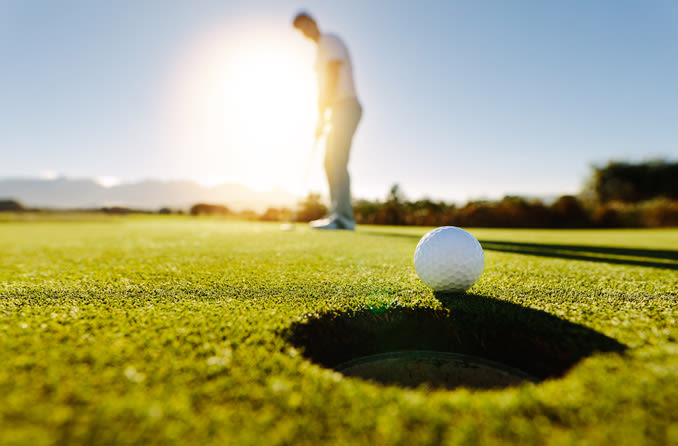Sports and active eyewear: Glasses that enhance performance

Sports glasses are eyeglasses specially designed to: 1) fit securely and comfortably during physical activity, 2) keep your eyes safe, and 3) enhance your vision to give you an extra performance "edge" in the sports you love.
In most sports, vision drives performance. To excel during competition, you should make sure your eyesight is in top shape. Even if you have 20/20 vision, the right sports eyewear can reduce glare and enhance contrast to help you see even better and react faster.
Sports glasses boost performance
Sports vision specialists agree that sports eyewear can have a profound effect on athletic performance. And research backs up this belief.
Researchers in the United Kingdom evaluated the effect of mildly blurred vision on the performance of Wimbledon tennis players and UK national clay pigeon shooting champions.
Athletes in the study wore special goggles that only slightly blurred their vision.
The tennis players' performance was evaluated by how accurately they could return a ball to an archery target set at the opposite baseline. The rifle shooters were judged by the number of clay pigeons they hit.
While wearing the vision-blurring goggles, the tennis players returned 62 percent more balls off-target than normal, with 47 percent fewer bulls-eyes.
Overall, the tennis players and shooters demonstrated a 25 percent worsening of performance when their vision was only slightly blurred.
Since this landmark study, other sports vision researchers have confirmed the importance of proper vision correction and visual skills in sports performance.
Sports vision experts have identified key features needed in sports glasses to provide maximum benefits for specific sports.
Sports glasses, goggles and eye protection
Experts agree that most sports-related eye injuries can be prevented if athletes wear protective eyewear, such as safety goggles with polycarbonate lenses.
Ski goggles should be considered a must on the slopes, and face shields (either "cages" or clear polycarbonate shields) should always be worn to protect an athlete's eyes.
Although kids may resist the idea of wearing safety glasses during sports, parents and coaches should insist. Without proper eye protection, many sports pose a risk of serious eye injuries and even blindness.
Also, never use everyday eyeglasses for sports glasses. Most everyday glasses are not made to the same protective standards as safety eyewear and could break or shatter under impact during sports and cause a serious injury.
Likewise, frames that don't qualify as safety eyewear can break upon impact or cause the lenses to come loose and damage the eyes or face.
Another danger during outdoor sports, even in winter, is ultraviolet (UV) radiation from the sun.
UV rays have been linked to eye diseases such as cataracts and ocular tumors. Overexposure to UV radiation also can cause a painful sunburn of your eyes called photokeratitis, which can lead to long-term damage to the cornea.
Skiers should always wear tinted goggles or sports sunglasses, since UV rays bounce off snow even on cloudy days. Boaters and sailors, too, need protection from UV rays that reflect off the water.
Sports sunglasses
Sport sunglass lenses can improve visibility, increase comfort, and reduce reaction time during sports played in sunlight outdoors.
You can choose from an almost endless variety of lens tints in sports sunglasses. Selectively filtering glare and certain colors can increase the contrast between objects of a particular color (a tennis ball, for example) and the sky or other background.
Tinted lenses that enhance the color yellow are desirable particularly in tennis, where they heighten the color of the ball and its contrast against the sky or stadium walls. Different lens tints can enhance specific colors for golfers, skiers, trap-shooters and other sports enthusiasts.
For example, golf glasses with copper-colored lenses enhance the contrast of a white golf ball against the sky and the green background of fairways and greens. And some professional baseball players wear amber-tinted glasses or sports contact lenses to help filter out blue light and increase their ability to see more clearly against the sky.
Controlling glare and adjusting to changes in lighting
Certain lens features can optimize visibility in different types of lighting:
Polarised sunglasses reduce glare so athletes can see the ball or other players better.
Anti-reflective (AR) coating is another glare reducer that works even at night, if you're playing under bright lights.
Photochromic lenses are another way to control light. These lenses are clear indoors and change automatically to a medium or dark sunglass shade outdoors, depending on the intensity of sunlight.
Regardless of your sport, polycarbonate lenses are generally considered the best type of lenses for sports eyewear. Polycarbonate lenses are significantly lighter and much more impact-resistant than lenses made of virtually any other material.
Photochromic lenses are terrific for golf, where you move frequently from bright sunlight to shade during the course of a round. They also are a great option for any outdoor sport on days when lighting conditions change throughout the day.
For the ultimate light-control lenses, many opticians recommend adding anti-reflective coating to photochromic lenses to eliminate glare from the "bounce-back" of light from the back surface of the lenses.
Personalized fittings of sports eyeglasses
Getting the best possible eyewear to maximize your sports performance starts with your eyeglass prescription.
Make sure your eyeglass prescription is up-to-date and tell your eye doctor which sports you enjoy.
Ask about the best frames and lenses for your particular sport and to view samples of different lens tints. Also, the fit of sports eyewear is very important for both safety and comfort.
When it comes to achieving your personal best in sports, remember that great eyesight is a key factor in athletic performance. For this reason, put sports eyewear at the top of your list when you shop for gear and accessories to enhance your sports performance.
Page published on Friday, 22 March, 2019





